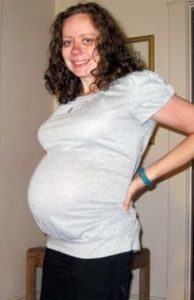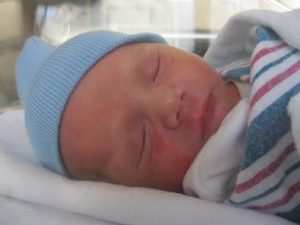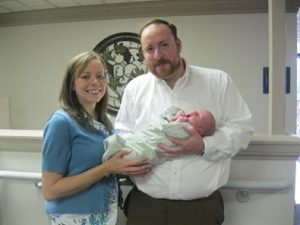Growing up, I always dreamed of being a mama. Fertility is a delicate topic for most women, not even considering the SA/CRS with which I was born. When I married at age 29, I wasn’t sure if I could or should try to have children. My first step was to go to my kidney doctor (nephrologist). Pregnancy is very hard on a woman’s kidneys, so my reasoning was that if my kidneys weren’t strong enough to carry a pregnancy, that ended the matter there. Thankfully, mine were fine at the time.
I then saw an orthopedist to see if my hips and pelvic area posed any specific problems to carrying a child to term. I am missing L5 and down. My orthopedist said that I would likely be able to carry a child but that natural delivery would not be a safe option for me because my pelvic area is simply too small.
My last step was to talk to my obstetrician/gynecologist. Although SA/CRS is not known to be genetic, she recommended taking a large dose of folic acid because being deficient in this vitamin has been shown to cause some neural tube defects, of which SA/CRS is one. I began taking 10x the normal dose of folic acid for about a month before trying to conceive. It took my husband and me 20 months to get pregnant because of polycystic ovarian syndrome (which isn’t related to SA/CRS).
 Finally pregnant, I was elated. My pregnancy was rather normal, all things considered. I did struggle with chronic urinary tract infections, which is normal for many pregnant mamas, but with the complications of SA/CRS, mine were bad. I was on antibiotics almost the entire pregnancy. I, fortunately, did not have to be on bedrest or have any extraordinary back or hip pain during my pregnancy.
Finally pregnant, I was elated. My pregnancy was rather normal, all things considered. I did struggle with chronic urinary tract infections, which is normal for many pregnant mamas, but with the complications of SA/CRS, mine were bad. I was on antibiotics almost the entire pregnancy. I, fortunately, did not have to be on bedrest or have any extraordinary back or hip pain during my pregnancy.
About a month before my due date, I happened to watch one of those labor and delivery shows on TV and noticed that the epidural for a C-section (which I would have to have) was rather low in the back. At my next obstetrician appointment, I brought it up to my doctor, who hadn’t thought of it either, and he referred me to see the hospital’s anesthesiologist. The epidural is generally placed between L4 and L5. Although I technically have those vertebrae, mine were so close together that the doctor was unsure if he would be able to insert an epidural safely, and he was unsure if I even had the nerves necessary for the epidural to work. An MRI before being pregnant (there are risks to an MRI when pregnant) would have answered this question, but it was too late for that. So with the anesthesiologist’s recommendation, we decided on a general-anesthesia C-section. I was disappointed because this meant I would be asleep and that my hus band would not be allowed in the operating room. But the safe delivery of my child outweighed any disappointment.
band would not be allowed in the operating room. But the safe delivery of my child outweighed any disappointment.
On May 29, 2012, I delivered a healthy, able-bodied baby boy. Recovery from a general anesthesia C-section is rough because your body tends to bleed more because of the anesthesia, so I was very weak from the blood loss.
We with SA/CRS are all so different. For some, biological parenthood is not an option. However, with adopting, fostering, step parenting, or god parenting children of friends or family, one can be a parent. If you do desire biological children, please see doctors and ask questions.
